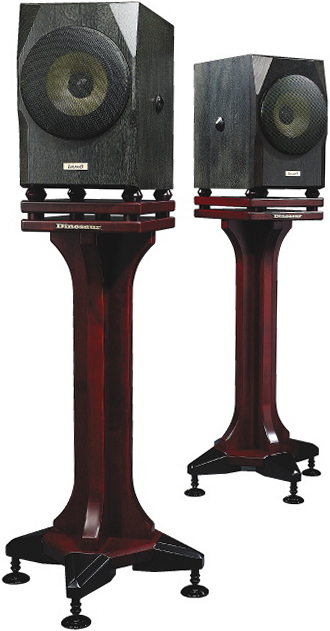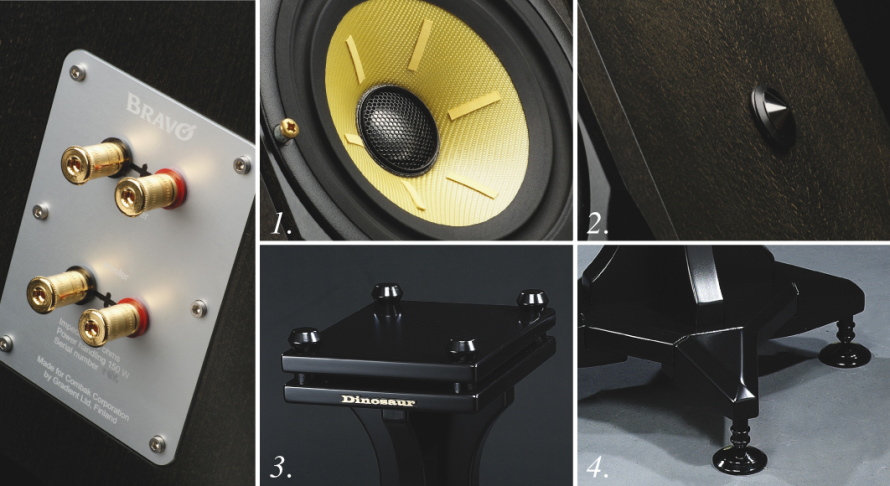BRAVO! Special Edition &
Dinosaur Tuning Speaker Stand
The Most Musical Small Speakers
By/Hong-ching Pu

COMBAK, a company founded by a master sound-tuner in Japan, Kazuo Kiuchi, has a rich product line-up thanks to Kiuchi’s careful management. His products include all types of tuning feet, cables, and electronics which even include pre-amps, amps, CD players, D/A converters, speakers, and matching stands.
What exactly are the factors and motivation that drove Kiuchi to create so many kinds of products? I believe the reasons are simple – the love for music and endless patience for getting the best sound!
Bravo is the only speakers Kiuchi has in his line-ups. These compact speakers use two coaxial single units and enclosed cases. Just like other Kiuchi products, Bravo looks simple, but it offers a sound that really is quite unique.
Kiuchi’s Amazing Hardware
Dinosaur Tuning Speaker Stands
Kiuchi even designed a set of speaker stands which he named “Dinosaur” just for Bravo. Isn’t it strange to have speaker stands with this kind of name? Yes. However, just take a look at them and you will understand why. This pair of stands has a “four-claw” design and comes with feet for each claw, making it look like a dinosaur’s claw on the ground!
Did Kiuchi design these speakers because of his sense of humor? Absolutely not; the design is purposeful. Kiuchi calls them “tuning speaker stands” and even believes they are a revolutionary, state-of-the-art product. These stands enhance speaker sound even when the speakers are not Bravo.
By far, Dinosaur tuning speaker stands are the weirdest stands I have seen. They are very light as each stand only weighs about 4kg (it says 4.8kg on the manual, probably including the weight of the claws and claw feet), but they have extremely unique structures and shapes which are difficult to be described in words, so it is better to just look at the photos.
Audiophiles would only need to take a further look to see that Kiuchi clearly designed the stands with his intentions. These stands clearly separate themselves from others and demonstrate Kiuchi’s tuning philosophy. The stand has 4 supporters instead of three, and the height of the claw-pins is also adjustable.
Here I’ll just let you know what’s going on with the stands. These bizarre Dinosaur stands have been designed completely for the purpose of tuning. Whether it is the board on the top or to the claws below all show Kiuchi’s genius. After trying them in person, the Bravo speakers and the stands do not only form a perfect sound emitter, but the stands can also work with any other brands of speakers and make them come alive, just as Kiuchi said. No wonder Kiuchi believes Bravo speakers have to be put on the Dinosaur stands in order to be pushed to the fullest.
The reason why I wrote about Dinosaur stands earlier is to tell all of you that when listening to Bravo speakers, the stands should be used in order to fully tap into their potential.
Bravo Coaxial Speakers with Finnish Nationality
Bravo speakers come in two versions: standard and special edition (SE). Both versions have the same specification, weight, and size. The only cosmetic difference is the SE speaker cones have been affixed with six reinforcement patches if you look through the grill.
Does Kiuchi have a speaker factory? No. In fact, his Bravo speakers are one of the products Kiuchi picked out from Gradient, a speaker factory in Finland. Kiuchi redesigned them and asked Gradient to do the modification. Based on my investigations, Bravo speakers are different from all Gradient products, making them genuinely a work by Kiuchi – even though the assembly was done by someone else. Besides, the final tuning of Bravo speakers was also done by Kiuchi.
There are not too much we can describe about these speakers’ appearance or working principles since each Bravo speaker is just a small unit that is 29cm in length, 19cm in width, and 18cm in depth. Seas coaxial single unit is installed in an enclosed body, and the yellow cone that looks like it is made of Kevlar is actually made of fiber glass. This coaxial single unit has a woofer that has an external diameter of 17cm, that of the aluminum convex cone tweeter is 25mm whose frequency separation is set at 28hh Hz. System response is 80Hz~20KHz +/- 2.5dB. -6dB point is at 55 Hz, efficiency is 87dB, resistance is 8 ohm. The specification indicates that the lowest resistance is 7 ohm, obviously preventing people from thinking that these are speakers are hard to push. The speaker terminal is WBT.
Based on the above specifications, there is really nothing too special about these speakers. Except the small patches on the cones (not in the standard model), the only thing unique about them is the cones on the two sides of each speaker. We just know they are Kiuchi’s trick to tune the speakers and have something to do with the resonance of the unit body. These small cones are not affixed on the body, however; they go through the board and reach inside the box.
Great Sound from Small Power Consumption
Since the manufacturer stressed that these speakers are easy to push, I hooked them up with Logic A35 that offers only 35W on each channel to try it out, and the result really surprised me! I was instantly hooked by Bravo’s clear sounds when I played the first track. The combination of A35 and Bravo is such a natural match that generates a clear and vibrant sound. Bravo is also sensitive to sound signals, fully utilizing A35’s characteristic of small power and low distortion. I originally put A35 with Bravo to see if the latter was indeed easy to push, but to my surprise, Bravo speakers aren’t only easy to push but work perfectly well with A35, and great sound was achieved with such ease. Although a bit weak in terms of the depth of sound, all the elements for great sound are certainly there!
Kiuchi’s culture of sound-tuning is the spirit behind the entire system. His 30 years of experience cannot be measured in dollars and cents!
Originally planning to listen to only a few tracks using A35, I actually enjoyed the combination for 3 days. On the second day, I suddenly remembered that I had Harmonix HS-101 GP signal cables and CS-120 speaker wires. I used these wires and connected the signal cable to Esoteric A10 and A35, and to my surprise, the sound instantly reached a whole new level with not only more power but more refined texture. The rich music was full of harmony and elegance, and the same music felt like it was played using the best feet Kiuchi has to offer. The depth of sound was enhanced, the content became richer, and acoustic smoothness and consistency was fully improved.
I have to honestly say that if you are not comparing the combination of A-35 and Bravo to high power hi-end sound systems for volume, dynamics, and low frequency, this combination offers a sweet sound that can definitely be compared to systems that cost several times more. I really didn’t expect to find the sound generated by Bravo and A35 that only costs about NT$10,000 far exceed their price tags. It really amazed me.
Making the Speakers Disappear Easily
Besides the A35, I also tried Bravo with VTL MB-185 Mono/Mono (NT$560,000) and TL 6.5 (NT$510,000). With the VTL model, the problem with sound depth found in Logic A35 was instantly solved, and the power and tension that were found in all the frequencies also made it hard to believe that Bravo speakers are small in size. The magnificent mid-range and the brilliant sound of the orchestra made these speakers sound like hi-end models. Although the amp costs much more than A35 does, I have to say only this kind of combination would allow us to push Bravo to the extreme.
My conclusion with Bravo SE is that it offers sufficient power and clarity. When listening to vocal music, the lyrics are extremely clear, and it is easy to hear the singer’s power. Although the manufacturer says Bravo is designed to be used in small spaces, its magnificent sound far exceeds what people expect from such a compact model, making them a great choice for generating deep and wide acoustic in a 30 square-meter room.
In terms of the acoustic performance, the low frequency is slightly low in terms of volume just as what its specification shows. However, since the speakers have enclosed boxes, the low frequency drops gradually instead of disappearing suddenly, keeping the acoustic integrity still at an ideal level. If you wish to get more low frequency performance, try to place them closer to walls or match them with ultra low frequency with excellent transience – a method that is rather difficult and shall be attempted by me sometime in the future.
Due to the coaxial single unit design, Bravo speakers are natural point sources, making it easy to grasp the relationship between the listener and the speakers. My advice is to sit about 1.5~2.5 meters from the speakers, toe them in a little bit, and keep their center at your ear level; this way, you will get great positioning and catch all the details.
Thanks to Kiuchi’s careful tuning, Bravo’s sound is harmonic, pleasant to the ears, vibrant, and sweet. If you put more effort in arranging the distance between the two speakers and their locations in your room, Bravo can easily disappear.
 |
|||
| 1. SE has patches to control the vibration of the cone, subtly giving the best sensation. | 2. The awls the go through the board must be there to make the vibration more even. | 3. The mysterious wood sound-tuning speaker stands can improve the sound quality of any speakers. | 4. A close-up of the Dinosaur. The pins and feet have to be used, and a balanced support is essential. |
Compared to speakers of a similar size, the same sound delivered by the Bravo SE speakers has a quieter background, stands out more, gives a clearer image of the musical instruments, has a higher density, packs more punch in the mid/low frequencies, and offers a brilliant gamut. When listening to percussion sounds, although the speakers offer a limited sense of volume, but the sense of resolution is far sharper and without any impurities, leaving a strong impression in my mind.
Kiuchi’s Dream Comes True
30 Years of Tuning Experience
To summarize, despite Bravo speakers’ ordinary appearance and the manufacturer’s lack of emphasis on technical specifications, they still deliver a sound that you just crave for more. Their musical performance is full of Kiuchi’s expertise. From the awls on the two sides of the speaker and the unique speaker stands to the RF-909 pads that come with the package, Bravo speakers truly distinguish themselves from ordinary speakers as the former clearly have more content and smarter design. Kiuchi’s tuning expertise is also the spirit that is seen throughout this system.
This pair of compact speakers that pack a “big” sound is priced at NT$168,000 for the standard model, and NT$228,000 for the SE version. Dinosaur costs NT$126,000, making these small speakers an expensive model among their competitors.
It is clear that Kiuchi has put the physical bodies of the speakers and his priceless tuning expertise together when designing them, allowing audiophiles who like his style to enjoy all the essence of his musical philosophy in one purchase.
During the one month when the Brave speakers were in our office for testing, I myself and other editors have really learned much since the value of Kiuchi’s 30 years of tuning is truly immeasurable.
 |
[close]